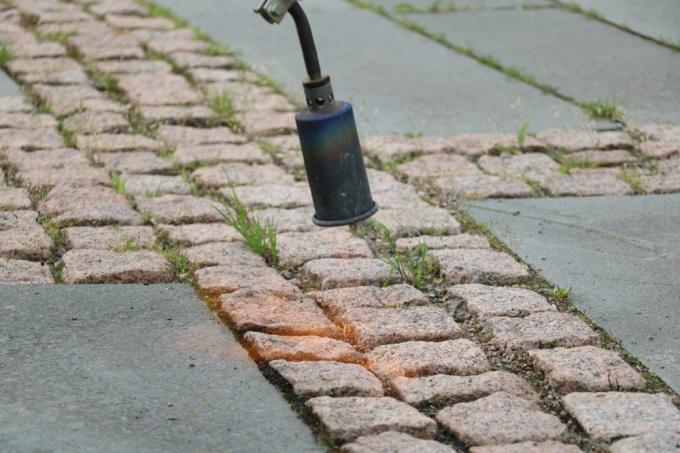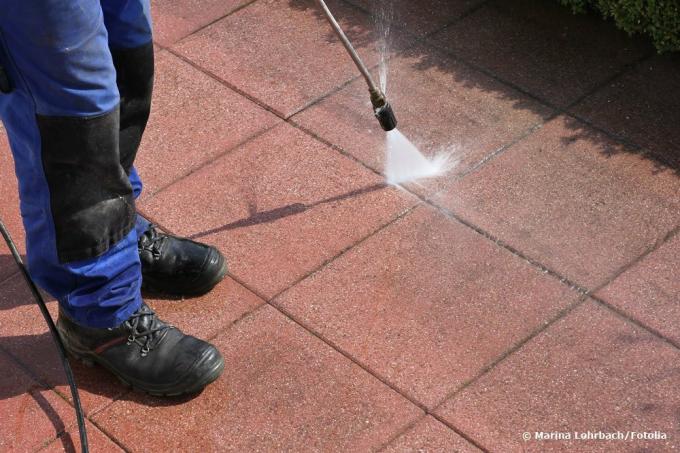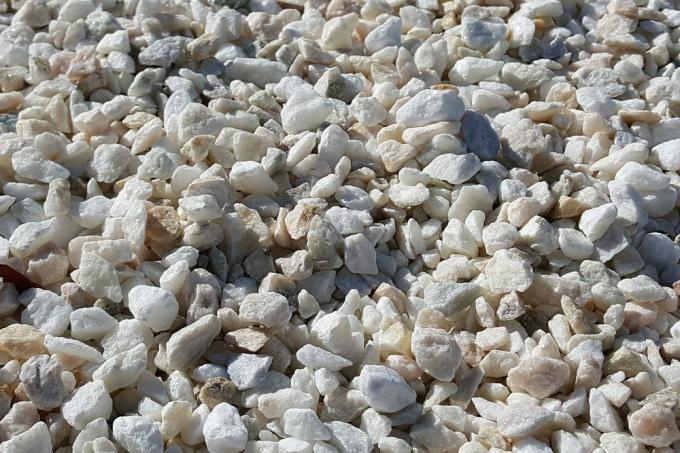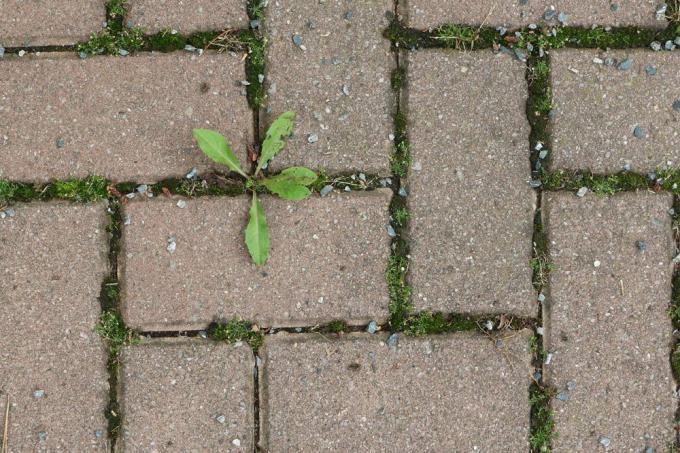
table of contents
- 5 best practices for removing weeds
- Manual removal
- Weed remover
- Weed burner
- Boiling water
- high pressure cleaner
- 4 tips for prevention
- Do not dispose of weeds on the compost
- Lay weed control
- Work in paving joint mortar
- Avoid multiplication
- frequently asked Questions
Weeds manually between Stones to remove is very tedious in the long run. Fortunately, there are also methods that use simple home remedies and aids. Of course, it is even better to prevent unwanted growth.
In a nutshell
- manual removal (tedious but environmentally friendly)
- use different devices
- do not use salt
- Use home remedies instead of chemicals
- Weed control or paving joint mortar for prevention
5 best practices for removing weeds
Manual removal
Manual removal is certainly the most environmentally friendly, but at the same time the most arduous and time-consuming method. This option is really only recommended for small terraces or steps. There is often a risk of back pain after work. In addition, the work puts a strain on the knees. A rubber cushion provides more comfort as a base so that you don't have to kneel on the hard stones.
Another important utensil are gloves. Since, depending on the width of the stone joints, a small cutter knife is recommended for scratching, users run the risk of slitting their fingertips on the stone edges.
The gardener must also make sure not only to cut off the above-ground growth, but also to remove the plant and its roots. This is the only way to prevent the weeds from reappearing after just a few days. A so-called tap root cutter can help not only tear off half of the plants.

Tip: After a rain shower, it is easier to scrape the unpleasant plants out of the ground. Of course, the conditions on dry days can also be optimized with the garden hose. So that the water seeps deep into the ground, users should flood the stones around an hour before weeding.
Weed remover
The time savings are limited, but a special weed remover offers a little more convenience. A model equipped with a telescopic handle is gentle on the back, as the user can work comfortably while standing.
An electric weed remover is even more worthwhile. However, this is not suitable for every soil. Some stones threaten to scratch with use.
Weed burner
The gardener uses a weed burner to destroy the plant and its roots. However, handling requires the utmost attention. Children and pets should be kept out of reach. The gardener must also move flammable material or sensitive flower pots beforehand. During use, he may only activate the heat in a vertical position. He must never point the burner at people.

Boiling water
It's not just the heat of a weed burner that kills the roots of the weed plant. If the application is too tricky for you, you can do it like grandmother did in the old days and pour boiling water into the joints. The only downside compared to the weed burner is that the plants won't burn completely. After the stones have dried, the gardener must manually pull them out of the ground and dispose of them.
When using it, it is important that the gardener pours the water over the joints close to the ground. If he pours the bucket of water onto the ground from a great height, he risks getting burned by the splashing drops.
Note: Unfortunately, this method only works for removing fine plant species. In the case of large-leaved weeds such as dandelions or thistles, the hot water only destroys young specimens. In most cases, several applications are also necessary.
high pressure cleaner
A pressure washer is only an option if the flooring material is suitable for use. In this case, the user benefits twice. The device not only helps to remove weeds from the joints, but at the same time cleans the floor and drives away ants, which often establish their states on terraces. All that is required is a water connection in the garden. How to remove weeds with a high-pressure cleaner:
- Connect the high pressure cleaner to the garden hose
- Spray water jet directly into the joints
- Then seal the joints with sand

Note: Even on hot summer days, users of a high-pressure cleaner should wear sturdy, closed-toe shoes (ideally rubber boots or safety shoes). Both the water and the splashing dirt particles can cause pain and injuries to the feet and shins due to the high pressure.
4 tips for prevention
Do not dispose of weeds on the compost
Anyone who owns a terrace or a driveway made of cobblestones knows that weed removal is usually only of short duration. A permanent absence of the annoying growth can hardly be achieved. However, many people unknowingly make a mistake that will speed up the return of plants.
After the weeds are scraped out of the joints, many gardeners dispose of the leftovers on the compost. Most of the time, the roots still cling to the plant and are quickly released from the wind. Therefore: residues must be disposed of in an airtight container with household or organic waste.
Lay weed control
If you think about overgrown plants while laying the stones, you will save yourself a lot of work. With a weed fleece, the gardener can effectively prevent dandelions and the like. This is a fine-pored material that he lays under the stone surface. Even delicate plants usually have no chance of penetrating the fleece and reaching the surface of the earth. Weed control panels are available from hardware stores.

Note: A gravel or crushed stone layer is an alternative to a weed fleece. However, it does not help against spore plants.
Work in paving joint mortar
Paving joint mortar is a resin-based aid with a very elastic consistency. The prevention method is also extremely weatherproof. After users have cleaned the grout, they sweep the grout into the grooves between the stones. Weeds will not appear for a long time.
Avoid multiplication
Anyone who discovers “weed herds” in the garden should act quickly and cut back the seed heads so that the plants do not spread. Weed-free stone joints are not one hundred percent guaranteed, but it still helps to curb the unpleasant growth.

Note: In principle, environmentally friendly home remedies are always preferable to chemical weed killers. In this case, however, Section 6 of the Plant Protection Act prohibits the use of the classic all-rounders vinegar and salt. The latter in particular seeps into the deep layers of the earth, pollutes the groundwater and changes the pH value of the soil.
frequently asked Questions
Not everyone has a pressure washer or a grout burner. If the permanent purchase is not worthwhile due to infrequent use, customers can simply borrow the equipment from the hardware store. In a good neighborhood, several families share a model that a friendly neighbor provides.
No, biological aids are also available in specialist shops. If customers are unsure, it is best to contact the staff.
No, sealing is probably the most effective method to permanently prevent growth. However, this measure can be very costly.
Weeding is very controversial indeed. Thistles and dandelions are important sources of food for bees and bumblebees. In stone joints on the terrace or the driveway, however, the vegetation simply looks unaesthetic and neglected. Not to mention the spread of moss, which even encourages weed growth. Anyone who uses environmentally friendly methods for removal and prevention does not have to feel guilty. Every gardener has to decide for himself whether dandelions and thistles can grow in the garden bed or on the lawn.
